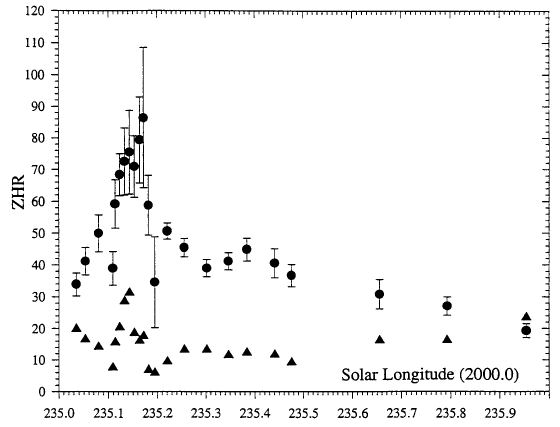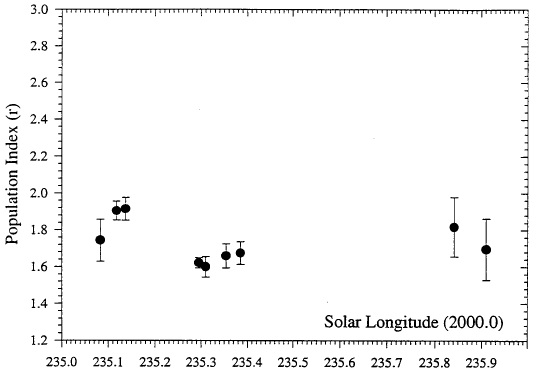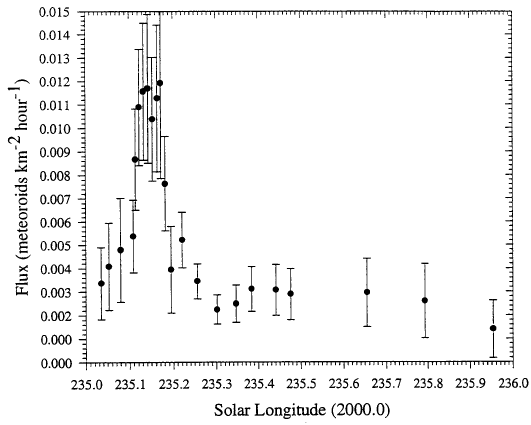
Published in WGN, the Journal of IMO 25:5, p. 210 (1997)
The parent comet was recovered on March 4, 1997 [1], very close to the predicted location based on the work of Yeomans et al. [2]. Pre-discovery observations of Tempel-Tuttle have also been found from as early as May of 1996 taken with the ESO 2.2 m telescope [3]. Current estimates of the nuclear radius of the comet based on its brightness at discovery suggest a value of 1.9 km, assuming an albedo of 0.04. This estimate is very similar to an earlier estimate by Sekanina [4] of 2 km based on the brightness of the comet at its 1965 passage. The refinement of this estimate along with further confirmation of the size of the comet using observations at other than visual wavelengths should provide some of the needed information for modelers to begin constructing more precise models of the dynamics of the stream in preparation for the strong Leonid returns expected from 1998 to 2000.
The 1996 return marks the first occasion when the narrow outburst component of the shower was unambiguously detected during the current Leonid epoch [5]. Though significant scatter does exist amongst the 10 or so observers reporting rate data during the outburst period, there appears to be enough information from these visual data to conclude that this component was observed in 1996. It would be most interesting to determine if other observational techniques detected this increase or not, but the time of occurence of the central portion of the outburst (5h UT on November 18) falls between the European and North American observing windows and makes independent confirmation less likely. Calibrated radio observations from 1996 could be particularly useful in this regard.
In addition to the outburst component, a broad level of activity consisting of larger particles, very similar to the profile seen in 1994 and 1995 was also detected.
A second, weaker peak is also visible in this profile near sol=235.4±0.1°. This peak is ill-defined within the error margins and is likely associated with the normal annual peak which has shown a maximum near sol=235.5° in past years [6]. The 1995 ZHR profile showed a very similar structure at this location [7]. The peak ZHR associated with this maximum is 45±4, which is more than 4 times the normal annual maximum and is 10 above the 1995 level. This peak is an order of magnitude broader than the early maximum having a HWHM of 0.6±0.2°. This HWHM is for the broad profile, ignoring the sharp early maximum. It is instructive to note from the sporadic and shower ZHR profiles that Leonid activity in 1996 climbed above the sporadic background only over the interval sol=234.0-236.0°.

Figure 1: ZHR versus solar longitude for the 1996 Leonid return. This profile was constructed using 0.1° smoothing intervals shifted by 0.05° before sol=235.1° and 0.02° intervals shifted by 0.01° during the period sol=235.1°-235.2°. The remainder of the profile was found using 0.1° increments shifted by 0.05° during the period sol=235.2°-235.5° and 0.5° increments shifted by 0.25° thereafter. The solid circles are shower ZHRs while the solid triangles are the sporadic HR in the corresponding intervals.

Figure 2: The r-profile for the 1996 Leonids as derived from magnitude data comprising 3220 Leonid meteors. Each datum was derived from a group of between 25 and 688 Leonid meteors.
From Figure 2, there is an increase in r near the time of the early ZHR peak relative to the intervals immediately before and following. The extreme minimum in r is reached near sol=235.31° when it attains a value of 1.6. This low value for r remains until at least sol=236.0° with values constant near 1.7-1.8. This is very much lower than the r=2 normally associated with the central portion of the stream and if true would indicate an abundance of brighter Leonids over the roughly day-long period centered about the normal peak as compared to quiet-time activity during the 1996 display. However, the abundance of bright meteors in this interval may be due to reduced observer attention to the fainter meteors as fewer experienced observers contributed data at the time of the minimum in the r-profile.
From the r-profile and the ZHR-activity it is possible to derive a flux profile for the 1996 Leonids and this is shown in Figure~3. The peak flux at the early peak corresponds to 0.012±0.004 meteoroids per square kilometer and per hour with absolute magnitudes brighter than 6.5. The later, broad peak is roughly 4 times lower than this value, in large part due to the very low values for r in this interval.

Figure 3: Flux profile for the 1996 Leonids.
A similar peak was observed in 1995, but with far less confidence. It is still not clear if this is a genuine feature of the stream or simply an artifact of the reductions and poor observer coverage in that year. The peak location for the possible outburst in 1995 is 4 hours earlier than in 1996, though the two just barely agree within the (large) errors for the location in 1995.
The location of the outburst peak is almost precisely the same as the location of the 1966 storm and an enhancement recorded by radar in 1965 [10]. This might imply that the material we are currently encountering has suffered virtually no perturbations in the intervening years and thus has not significantly changed its nodal longitude. Kazimircak-Polonskaja et al. [11] were among the first to explicitly point out that the mean secular advance of the nodes of the stream (amounting to some 29' per revolution) is actually achieved through a number of punctuated advances associated with perturbations from Jupiter, Saturn, and Uranus. Thus the actual rate of change for any one Leonid meteoroid from one revolution to the next may be anywhere from nearly 0 to several times the average rate. According to Kazimircak-Polonskaja et al. [11], the portions of the stream likely to be nearest to the Earth in 1999 shows virtually no change in nodal longitude between 1950 and 2000. In particular this section of the stream maintains essentially identical nodal longitudes from 1966 to 2000. If this is in fact the case, then the activity we have first seen in 1996 presages the probable location of the shower peaks over the years 1997-2001. Similar results were also found by Brown and Jones [12] on the basis of numerical modeling of the stream who suggested shower peaks during the current Leonid epoch would be most probably near sol=235.16°. Further detailed modeling needs to be done in light of the recovery of the parent comet and a key observation during the 1997 Leonid return will be the presence or absence of a strong component of the shower near these solar longitudes.
Unfortunately, the rather promising shower activity is hindered to a large degree by an 18-day old Moon on the night of maximum. The Moon will rise well before the radiant and will not set until after sunrise thus eliminating any possibility for dark-sky viewing of the shower. Nevertheless, careful observations at the time of maximum and magnitude estimates may help to roughly define the peak ZHR (as in n1994) as well as provide some reference as to any relative changes in the particle make-up across the stream.
If the patterns from the last few years persist, it seems probable that there will be an extended level of activity lasting perhaps 2 days centered around the peak with a peak ZHR of 50-60 in 1997 composed of larger Leonids. The visibility of the outburst maximum will be heavily compromised by the Moon, but some TV observations as well as careful radio/radar measurements of activity of the stream may be able to detect the expected flurry of fainter meteoroids from the Ortho-Leonids. The position of the outburst maximum detected in 1996 will recur at 11h UT on November 17 in 1997 and will be best seen from the Central and Western United States. The time of nodal crossing in 1997 is 13.5h UT, which places best viewing on the extreme West Coast of North America and Hawaii. The "normal" maximum at sol=235.5° occurs at 19h UT, and will be best seen from Eastern Asia.
As activity associated with the first maximum in 1996 had a higher r-value than adjacent periods, particular attention is drawn to the possibility of numerous faint meteors (which will certainly be difficult to see due to the moonlight) in addition to the probable large number of brighter events.
[2] D.K. Yeomans, K.K. Yau, P.R. Weissman: The Impending Appearance of Comet Tempel-Tuttle and the Leonid Meteors. Icarus 124, 1996, pp. 407-413
[3] O.R. Hainaut, K.J. Meech, J. Bauer, R.M. West: Recovery of 55P/Tempel-Tuttle. Meteoritics and Planetary Science 32, 1997, pp. A53-A54
[4] Z. Sekanina: Meteoric Storms and the Formation of Meteor Streams. In Asteroids, Comets, and Meteoric Matter, C. Cristescu, W.J. Klepczynski, and B. Milet (eds.), Scholium International, New York, 1974, pp. 239-267
[5] M. Langbroek: Observation of a Narrow Component of Faint Leonids in 1996. WGN 24:6, 1996, pp. 207-208
[6] P. Brown: Significantly Enhanced Leonid Activity in 1994: Bulletin 5 of the International Leonid Watch. WGN 22:6, 1994, pp. 190-193
[7] Brown P.: Bulletin 8 of the International Leonid Watch, WGN 24:5, 1996, pp. 139-141
[8] B.A. McIntosh, P.M. Millman: The Leonids by radar - 1957 to 1968. Meteoritics 5, 1970, pp. 1-18
[9] R. Arlt, J. Rendtel, P. Brown: ILW Bulletin 9: Results of the 1996 Leonid Maximum. WGN 24:6, 1996, pp. 203-206
[10] P. Brown, M. Simek, J. Jones: Radar Observations of the Leonids: 1964-1995. Astronomy and Astrophysics 322, 1997, pp. 687-695
[11] E.I. Kazimircak-Polonskaja, N.A. Belijaev, I.S. Astapovic, A.K. Terentjeva: Investigation of the Perturbed Motion of the Leonid Meteor Stream. In Physics and Dynamics of Meteors, L. Kresak and P.M. Millman (eds.), 1968, pp. 449-476
[12] P. Brown, J. Jones: Dynamics of the Leonid Meteoroid Stream: A Numerical Approach. In Physics, Chemistry, and Dynamics of Interplanetary Dust, B.A.S. Gustafson, M.S. Hanner (eds.), 1996, pp. 113-117